i don't agree with vivek jha
properties are:-
it travels in straight lines(rectilinear propagation of light)
they travel at high speeds (300000 km/s)
they can travel through vaccum.
SHORT AND SWEET :)
- 6
Light Light is electromagnetic radiation that has properties of waves. The electromagnetic spectrum can be divided into several bands based on the wavelength of the light waves. As we have discussed before, visible light represents a narrow group of wavelengths between about 380 nm (1 nm = 10-9 m) and 730 nm. |
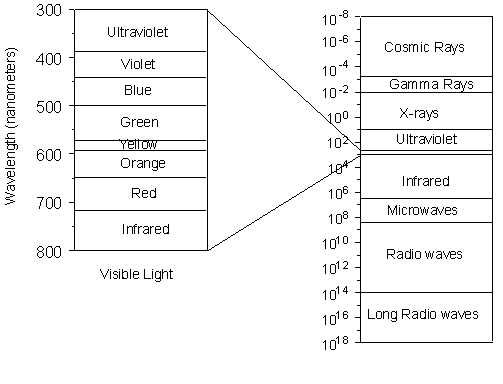 |
| Our eyes interpret these wavelengths as different colors. If only a single wavelength or limited range of wavelengths are present and enter our eyes, they are interpreted as a certain color. If a single wavelength is present we say that we have monochromatic light. If all wavelengths of visible light are present, our eyes interpret this as white light. If no wavelengths in the visible range are present, we interpret this as dark. Interaction of Light with Matter Velocity of Light and Refractive Index The energy of light is related to its frequency and velocity as follows: E = hn = hC/l where E = energy The velocity of light, C, in a vacuum is 2.99793 x 1010cm/sec. Light cannot travel faster than this, but if it travels through a substance, its velocity will decrease. Note that from the equation given above- C = nl The frequency of vibration, n, remains constant when the light passes through a substance. Thus, if the velocity, C, is reduced on passage through a substance, the wavelength, l, must also decrease. We here define refractive index, n, of a material or substance as the ratio of the speed of light in a vacuum, C, to the speed of light in a material through which it passes, Cm. n = C/Cm Note that the value of refractive index will always be greater than 1.0, since Cm can never be greater than C. In general, Cm depends on the density of the material, with Cm decreasing with increasing density. Thus, higher density materials will have higher refractive indices. The refractive index of any material depends on the wavelength of light because different wavelengths are interfered with to different extents by the atoms that make up the material. In general refractive index varies linearly with wavelength. Materials can be divided into 2 classes based on how the velocity of light of a particular wavelength varies in the material.
Air, since it is a gas, is isotropic. The refractive index of air is usually taken as 1.0, although its true value is 1.0003.
|
| Reflection and Refraction of Light When light strikes an interface between two substances with different refractive indices, two things occur. An incident ray of light striking the interface at an angle, i, measured between a line perpendicular to the interface and the propagation direction of the incident ray, will be reflected off the interface at the same angle, i. In other words the angle of reflection is equal to the angle of incidence. |
If the second substance is transparent to light, then a ray of light will enter the substance with different refractive index, and will be refracted, or bent, at an angle r, the angle of refraction. The angle of refraction is dependent on the angle of incidence and the refractive index of the materials on either side of the interface according to Snell's Law:
Note that if the angle of incidence is 0o (i.e. the light enters perpendicular to the interface) that some of the light will be reflected directly back, and the refracted ray will continue along the same path. This can be seen from Snell's law, since sin(0o) = 0, making sin (r) = 0, and resulting in r = 0. | 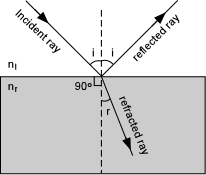 |
There is also an angle, ic, called the critical angle for total internal reflection where the refracted ray travels along the interface between the two substances. |
| This occurs when the angle r = 90o. In this case, applying Snell's law: ni sin (ic) = nr sin (90o) = nr [since sin (90o) = 1] | 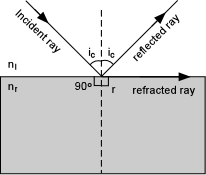 |
Dispersion of Light The fact that refractive indices differ for each wavelength of light produces an effect calleddispersion. This can be seen by shining a beam of white light into a triangular prism made of glass. White light entering such a prism will be refracted in the prism by different angles depending on the wavelength of the light. |
| The refractive index for longer wavelengths (red) are lower than those for shorter wavelengths (violet). This results in the a greater angle of refraction for the longer wavelengths than for the shorter wavelengths. (Shown here are the paths taken for a wavelength of 800 nm, angle r800 and for a wavelength of 300 nm, angle r300). When the light exits from the other side of the prism, we see the different wavelengths dispersed to show the different colors of the spectrum. | 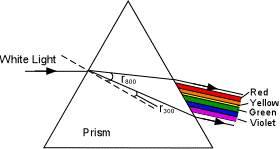 |
Absorption of Light When light enters a transparent material some of its energy is dissipated as heat energy, and it thus looses some of its intensity. When this absorption of energy occurs selectively for different wavelengths of light, they light that gets transmitted through the material will show only those wavelengths of light that are not absorbed. The transmitted wavelengths will then be seen as color, called the absorption color of the material. |
| For example, if we measure the intensity of light, Io, for each wavelength before it is transmitted through a material, and measure the intensity, I, for each wavelength after it has passed through the material, and plot I/Io versus wavelength we obtain the absorption curve for that material as shown here. The absorption curve (continuous line) for the material in this example shows that the light exiting the material will have a yellow-green color, called the absorption color. An opaque substance would have an absorption curve such as that labeled "Dark", i.e. no wavelengths would be transmitted. | 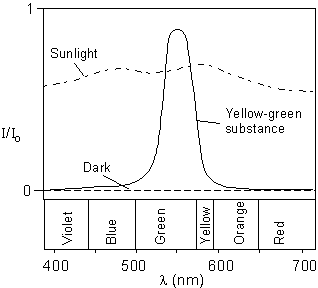 |
| Sunlight, on passing through the atmosphere has absorption curve as shown, thus we see it as white light, since all wavelengths are present. |
Polarization of Light Normal light vibrates equally in all direction perpendicular to its path of propagation. If the light is constrained to vibrate in only on plane, however, we say that it is plane polarized light. The direction that the light vibrates is called the vibration direction, which for now will be perpendicular to the direction. There are two common ways that light can become polarized. |
| 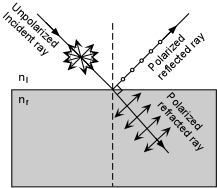 |
|
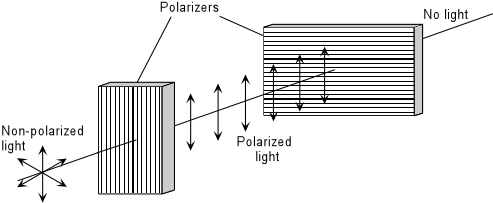 |
If a beam on non-polarized light encounters a polarizer, only light vibrating parallel to the polarizing direction of the polarizer will be allowed to pass. The light coming out on the other side will then be plane polarized, and will be vibrating parallel to the polarizing direction of the polarizer. If another polarizer with its polarization direction oriented perpendicular to the first polarizer is placed in front of the beam of now polarized light, then no light will penetrate the second polarizer. In this case we say that the light has been extinguished. |
Polaroid sunglasses use these same principles. For example, incoming solar radiation is reflected off of the surface of the ocean or the painted hood of your car. Reflected light coming off of either of these surfaces will be polarized such that the vibration directions are parallel to the reflected surface, or approximately horizontal (as in the first method of polarization discussed above). Polaroid sunglasses contain polarizers with the polarization direction oriented vertically. Wearing such glasses will cut out all of the horizontally polarized light reflecting off the water surface or hood of your car.
|
The Polarizing Microscope In optical mineralogy we use a microscope called a polarizing microscope. Such a microscope is equipped with two polarizers that are normally oriented so that their polarization directions are perpendicular to one another. |
| Light from a light source located below the tube and stage of the microscope is initially unpolarized. This light first passes through the lower polarizer (usually just called the polarizer), where it becomes polarized such that the light is vibrating from the users right to left. These directions are referred to as East (right and West (left). The light then passes through a hole in the rotatable stage of the microscope and enters the lower lens, called the objective lens. Mounted within the microscope tube is a second polarizer, called the analyzer, that can be rotated or pushed so that in can be in the light path (inserted position) or not in the light path (analyzer out position). The analyzer has a polarization direction exactly perpendicular to that of the lower polarizer These directions are usually referred to as North - South. If the analyzer is in, then the plane polarized light coming from the lower polarizer will be blocked, and no light will be transmitted though the ocular lens above. If the analyzer is out, so that it is not in the light path, then the polarized light will be transmitted through the ocular lens. | 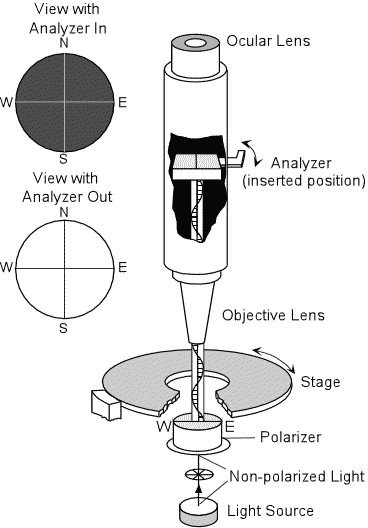 |
| Next time we will see how this microscope is used to examine isotropic substances and determine their refractive indices. |
- -1


